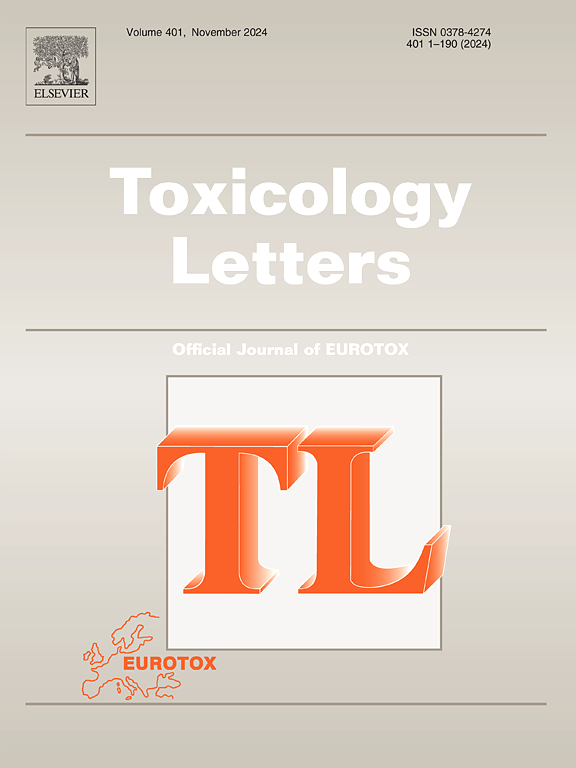追踪蓖麻毒素及其活性的一系列试验
IF 2.9
3区 医学
Q2 TOXICOLOGY
引用次数: 0
摘要
蓖麻毒素是一种 2 型核糖体激活蛋白(RIP),是从蓖麻籽中提取的危险生物毒素。它被《化学武器公约》(CWC)列为附表 1 物剂,被《生物和毒素武器公约》(BTWC)列为 B 类物剂。尽管毒性很高,蓖麻籽植物仍被广泛用于生产蓖麻油,并在民间医药系统中用于治疗各种疾病。由于缺乏食品和药物管理局 (FDA) 批准的药物,因此及早发现生物活性蓖麻毒素对于及时采取适当的应对措施以避免人员伤亡至关重要。需要采用综合方法来区分纯蓖麻毒素和粗蓖麻毒素以及活性/非活性蓖麻毒素。本研究进行了一系列生物测定,以确定生物活性蓖麻毒素及其不同形式。评估包括实地和实验室检测,以检测和区分蓖麻毒素的不同异构体。使用的检测方法包括侧流试验(LFA)、血凝试验(HA)、体外转化系统(IVTS)、细胞毒性试验(CA)和小鼠保护试验(MPA)。考虑到蓖麻毒素污染的情况,第一步是使用 LFA 定性地确定蓖麻毒素的存在。随后,对 HA 进行了优化,以区分粗蓖麻毒素和纯蓖麻毒素。除此之外,该检测方法还能区分各种栽培品种和异构体。IVTS 检测法用于确定蓖麻毒素 A 链的酶活性,该酶抑制翻译机制的 IC50(50% 抑制浓度)为 11.2 纳克/毫升。用抗蓖麻毒素兔多克隆抗体(RPAb)进一步中和,证实了蓖麻毒素介导的翻译抑制作用,并排除了使用其他 RIPs(abrin、saproin 和 viscumin)的可能性。HeLa 细胞的细胞毒性被用作细胞模型,估计 CC50 值(50% 细胞毒性浓度)为 36 ng/ml。用 RPAb 进行的中和实验特异性地逆转了蓖麻毒素诱导的细胞毒性。使用 5 倍半数致死剂量的蓖麻毒素进行了小鼠保护试验,结果显示,蓖麻毒素会在 48 小时内导致小鼠死亡。RPAb 提高了存活率,抑制了蓖麻毒素的存在,并消除了相关 RIPs 的存在。从野外到实验室,所有建议的检测方法都能满足蓖麻毒素暴露情况下的要求。这些检测方法还能区分蓖麻毒素的粗品/纯品/栽培品种和异构体。在紧急情况下,结合使用这些检测方法将有助于我们更快地做出决定,并延长治疗时间窗口。本文章由计算机程序翻译,如有差异,请以英文原文为准。
A battery of assays for chasing ricin and its activity
Ricin, a type-2 Ribosome-Inactivating Protein (RIP), is a dangerous biotoxin derived from castor plant seeds. It is classified as a Schedule 1 agent by the Chemical Weapon Convention (CWC) and a Category B agent by the Biological and Toxin Weapon Convention (BTWC). Despite their high toxicity, castor seed plants are widely used for the production of castor oil and in folk medicine systems for the treatment of various diseases. Due to the lack of a Food and Drug Administration (FDA) approved medication, early detection of biologically active ricin is critical for implementing suitable countermeasures in time to avert casualties. It is required to employ an integrated approach to distinguish between pure and crude ricin as well as active/inactive ricin. In the present study, a series of bioassays were performed to identify biologically active ricin and its different forms. This assessment included both field and lab-based assays to detect and differentiate different isoforms of ricin. The assays used are the lateral flow assay (LFA), hemagglutination assay (HA), In-vitro translational system (IVTS), cytotoxicity assay (CA), and mouse protection assay (MPA). Considering the ricin-contaminated scenario, the first step was to qualitatively determine the presence of ricin using LFA. Following that, a HA was optimized to differentiate between crude and pure ricin. In addition to this, the assay was also able to differentiate various cultivars and isoforms. IVTS assay was used to identify the enzymatic activity of the ricin A chain that inhibited translational machinery with IC50 (50 % inhibitory concentration) of 11.2 ng/ml. Further neutralization with anti-ricin rabbit polyclonal antibodies (RPAb) confirmed the ricin-mediated translation inhibition and excluded the use of other RIPs (abrin, saproin, and viscumin). Cytotoxicity in HeLa cells was used as a cellular model with an estimated CC50 value (50 % cytotoxic concentration) of 36 ng/ml. The neutralization experiment with RPAb specifically reversed the ricin-induced cytotoxicity. A mouse protection assay was done using 5X LD50 of ricin, which caused mortality within 48 h. RPAb increased the survival, verdict the presence of ricin, and eliminated the presence of related RIPs. All the proposed assays suffice the requirement during ricin exposure scenario from the field to the laboratory. These assays are also capable of distinguishing crude/pure/cultivars, and isoforms of ricin. During an emergency, a combination of these assays will help us to make faster decisions and increase the therapeutic time window for treatment.
求助全文
通过发布文献求助,成功后即可免费获取论文全文。
去求助
来源期刊

Toxicology letters
医学-毒理学
CiteScore
7.10
自引率
2.90%
发文量
897
审稿时长
33 days
期刊介绍:
An international journal for the rapid publication of novel reports on a range of aspects of toxicology, especially mechanisms of toxicity.
 求助内容:
求助内容: 应助结果提醒方式:
应助结果提醒方式:


